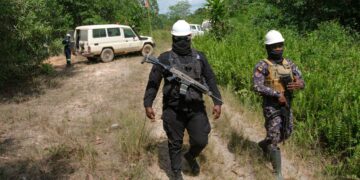The Pakistan Stock Exchange on Wednesday recovered from early losses to tank 1,000 points after reports of an Indian strike on terror camps in Pakistan-occupied Kashmir (PoK).
The Pakistan Stock Exchange’s flagship KSE100 index opened 6,560.82 points lower at 107,007.68, down 5.78 per cent on Wednesday. It was down 1,211 points or 1.07 per cent to 112,356.89 at 11:21 am on Wednesday.
To be sure, the KSE 100 closed in red on Tuesday even after a rate cut by the State Bank of Pakistan, according to a note posted by brokerage Arif Habib Ltd on social media platform X. The exchange closed 533.73 points lower on Tuesday.
The Indian armed forces launched ‘Operation Sindoor’ on terror infrastructure in Pakistan and Pakistan-occupied Jammu and Kashmir, the Defence Ministry said in an official statement on Wednesday. The terror attacks against India have been planned and carried out from these facilities, it added.
No Pakistani military facilities were targeted during the attack. “These steps come in the wake of the barbaric Pahalgam terrorist attack in which 25 Indians and 1 Nepali citizen were murdered,” the Defence Ministry stated.
Amid broader economic challenges, KSE100 remains in red

Investors remained bearish on Tuesday amid strong ongoing border tensions, the Dawn Pakistan reported, citing analysts.
A Moody’s report cautioning that India-Pakistan tensions could affect Pakistan’s economic stability also weighed on the KSE100.
Story continues below this ad
The Pakistan Indus Water Authority also alleged on Tuesday that India had blocked 90 per cent of the water flows from the Chenab river, Pakistani daily the Dawn reported.
Drawing on historic market trends for May, SIA Equities in a note on historic trends in the KSE100 stated bears have had an upper hand since 2010 in eight instances while the indices have been bullish in seven years.
Moody’s warns against impact of India-Pak tensions
An escalation in India-Pakistan tensions is expected to “weigh on Pakistan’s growth and hamper the government’s ongoing fiscal consolidation,” rating agency Moody’s said in its report.
It could also affect Pakistan’s access to external financing while exerting pressure on its foreign exchange reserves, according to the report.
Story continues below this ad
On May 9, the IMF’s executive board will meet Pakistani officials for a fresh credit line of $1.3 billion to Islamabad under the climate resilience loan programme. The IMF will also review the ongoing $7 billion bailout package extended to Pakistan.
State Bank of Pakistan cuts key rate
The State Bank of Pakistan, the neighbouring country’s central bank, slashed the key rate by 100 basis points to 11 per cent on Tuesday. While the KSE100 surged over 900 points in response to this development on Tuesday, the trend reversed soon and the key Pakistani index closed over 500 points lower.
Pakistan Business Council CEO Ehsan Malik said the quantum of rate cut by SBP was inadequate citing expanding trade deficit due to a rise in imports, the Dawn reported.
Malik said trade uncertainty, geopolitical tensions, and pressure on the exchange rate were also reasons for urging the SBP to bring the key rate down to a single digit.
Story continues below this ad
Pakistan’s industry was expecting a 500 bps rate cut to 7 per cent, said Atif Ikram Sheikh, President of the Federation of Pakistan Chambers of Commerce and Industry, the Dawn reported. The policy rate commanded a premium compared to the Consumer Price Index of inflation in Pakistan, which stood at 0.30 per cent in April, he added.
“Pakistani industries continue to suffer under unsustainably high borrowing costs,” said Karachi Chamber of Commerce and Industry president Muhammad Jawed Bilwani, while comparing SBP’s policy rate with neighbouring India’s (6 per cent) and that of Bangladesh (10 per cent) among other countries in the region, the Dawn reported.














